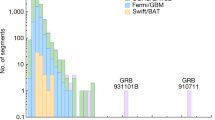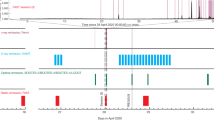Abstract
WE report on an experiment to search for cosmic γ-ray bursts of the type discovered by Klebesadel et al.1, but of smaller size and of sufficient frequency of occurrence to be detected during a 1-d observation program. Two similar detectors, successfully balloon-borne from launch sites in South Dakota and Texas, achieved about 20 h of simultaneous operation at several millibars atmospheric depth, with continuous separation of over 1,500km on 10–11 May 1975. Fluctuations of the counting rates of >150keV photons with temporal structures from microseconds to several minutes were compared in order to detect coincident or associated responses from the two instruments. The results of this experiment can be summarised as follows. First, no coincident γ-ray burst events were detected. Second, the resulting integral size spectrum of small bursts, from this and from all other searches, remains a spectrum of upper limits, consistent with an extrapolation of the size spectrum of the largest known bursts, fitting a power law of index –1.5. Third, a curious effect was found which can be described as consisting of associated, but not coincident, counting-rate increases of photons of energy >150keV. This phenomenon undoubtedly presents a background, event-confusion problem for any single γ-ray burst instrument, placed either on balloons or on satellites which orbit the Earth beneath the trapped radiation.
This is a preview of subscription content, access via your institution
Access options
Subscribe to this journal
Receive 51 print issues and online access
$199.00 per year
only $3.90 per issue
Buy this article
- Purchase on Springer Link
- Instant access to full article PDF
Prices may be subject to local taxes which are calculated during checkout
Similar content being viewed by others
References
Klebesadel, R. W., Strong, I. B. & Olson, R. A. Astrophys. J. Lett. 182, L85–L88 (1973).
Strong, I. B. & Klebesadel, R. W. Nature 251, 396–397 (1974).
Cline, T. L. Ann. N.Y. Acad. Sci. 262, 159–163 (1975).
Fabian, A. C. Nature 256, 347–348 (1975).
Strong, I. B. & Klebesadel, R. W. Nature 256, 348 (1975).
Cline, T. L. & Desai, U. D. Astrophys. Space Sci. 42, 17–27 (1976).
Cline, T. L. & Desai, U. D. Proc. 13th Int. Cosmic Ray Conf. OG- 1, 80–85 (1973).
Cline, T. L. & Desai, U. D. Astrophys. J. Lett. 196, L43–L46 (1975).
Strong, I. B., Klebesadel, R. W. & Olson, R. A. Astrophys. J. Lett. 188, L1–L3 (1974).
Cline, T. L. & Schmidt, W. K. H., Goddard Preprint X-661-76-222 (1976); Nature (in the press).
Carter, J., Dean, A. J., Manchanda, R. K. & Ramsden, D. Nature 262, 370–371 (1976).
Bewick, A., Coe, M. J., Mills, J. S. & Quenby, J. J. Nature 258, 686–687 (1975).
Johnson, W. N., Kurfess, J. D. & Bleach, R. D. Astrophys. Space Sci. 42, 35–42 (1976).
Herzo, D., Dayton, B., Zych, A.D. & White, R. S. Astrophys. J. Lett. 203, L115–L118 (1976).
Author information
Authors and Affiliations
Rights and permissions
About this article
Cite this article
CLINE, T., DESAI, U., SCHMIDT, W. et al. Search for γ-ray bursts with coincident balloon flights. Nature 266, 694–696 (1977). https://doi.org/10.1038/266694a0
Received:
Accepted:
Issue Date:
DOI: https://doi.org/10.1038/266694a0
This article is cited by
-
The goddard program of gamma-ray transient astronomy
Astrophysics and Space Science (1981)
-
Gamma-ray burst measurements with A 6.3 m2 array
Astrophysics and Space Science (1981)
-
Distance limit for a class of model γ-ray burst sources
Nature (1978)
-
Evidence that cosmic γ-ray bursts are galactic
Nature (1978)
Comments
By submitting a comment you agree to abide by our Terms and Community Guidelines. If you find something abusive or that does not comply with our terms or guidelines please flag it as inappropriate.



